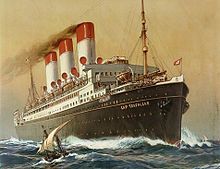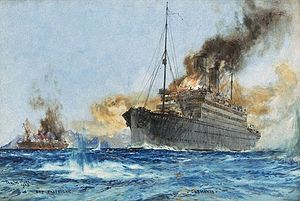SMS Cap Trafalgar

Cap Trafalgar
by Willy Stöwer |
|
| History | |
|---|---|
|
|
|
| Name: | Cap Trafalgar |
| Owner: | Hamburg Südamerikanische Dampfschifffahrts-Gesellschaft |
| Builder: | AG Vulcan, Hamburg (Germany) |
| Yard number: | 334 |
| Launched: | 31 July 1913 |
| In service: | 1 April 1914 |
| Homeport: | Hamburg |
| Fate: | Sunk in combat, 14 September 1914 |
| General characteristics | |
| Tonnage: | 18,710 GRT |
| Displacement: | 23,640 tons |
| Length: | 613 ft (187 m) |
| Beam: | 72 ft (22 m) |
| Installed power: | 15,000 shaft horsepower |
| Propulsion: | Twin steam 4-cylinder triple expansion engines with turbines; 3 screws |
| Speed: | 17 knots |
| Sinking of SMS Cap Trafalgar | |||||||
|---|---|---|---|---|---|---|---|
| Part of World War I War at Sea |
|||||||
 Carmania sank Cap Trafalgar off Trindade. |
|||||||
|
|||||||
| Belligerents | |||||||
|
|
|
||||||
| Commanders and leaders | |||||||
|
|
|
||||||
| Strength | |||||||
| 1 auxiliary cruiser | 1 auxiliary cruiser | ||||||
| Casualties and losses | |||||||
| 16-51 killed, unknown wounded, 279 captured, 1 auxiliary cruiser sunk |
9 killed, unknown wounded, 1 auxiliary cruiser damaged |
||||||
SMS Cap Trafalgar (also called Cape Trafalgar) was a German passenger liner converted to an auxiliary cruiser during World War I. The ship holds the distinction of being the first armed merchant cruiser to have been sunk by a ship of the same class; she was destroyed in a furious action in the South Atlantic in September 1914 soon after the start of the war.
The passenger liner SS Cap Trafalgar was built at the AG Vulcan Shipyard on the Elbe River in Hamburg, Germany for the Hamburg-South America Line for their service between Germany and the River Plate (Río de la Plata). She was named after the Spanish Cape Trafalgar, scene of the famous Battle of Trafalgar in 1805. A three-funneled vessel of 613 ft (187 m) length and 72 ft (22 m) beam, she measured 18,710 GRT and could carry nearly 1,600 passengers (400 1st class, 276 2nd class, 913 3rd or steerage class. A triple-screw vessel, her outer propellers were powered by two triple-expansion steam engines, and the centre screw by an exhaust turbine, an arrangement similar to that of the RMS Titanic.
When Cap Trafalgar began her maiden voyage on 10 April 1914 from Hamburg for South American ports in Brazil, Argentina and Uruguay, she was the largest vessel hitherto on the South American service and among the most luxurious.
...
Wikipedia
